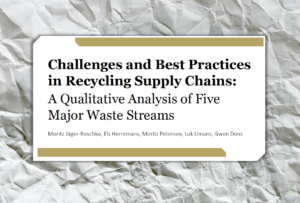Recycling activities are complex and involve many actors. Recycling supply chains are under increasing pressure due to higher volumes of waste and rising requirements regarding the treatment and quality of the secondary raw materials. The global generation of municipal solid waste is estimated to be two billion tons per year. It is expected to rise by 30% by 2030 and 70% by 2050, leading to up to 3.4 billion tons of waste generated worldwide in 2050. This already staggering number only includes municipal waste, excluding other major solid waste sources like construction and demolition waste or post-industrial waste.
All waste needs to be collected and processed correctly to avoid further environmental pollution. The increasing amount of waste, combined with the increasing complexity and variety of end-of-life products and materials, is putting heightened pressure on the recycling industry. At the same time, manufacturers are increasing their requirements toward secondary raw materials resulting from the recycling process.
The increased requirements are due to continuously rising consumer expectations and stricter legislation concerning the composition of materials used during production, for example, REACH (Registration, Evaluation, Authorisation, and Restriction of Chemicals) or POP (Persistent Organic Pollutants) directives. Additionally, the EU and multiple national governments are increasing the recycling quotas, meaning that more secondary raw material needs to be produced from the products and material that are discarded by consumers. To cope with these challenges, a joint effort of all actors involved in the treatment of waste is necessary.
Currently, there are substantial differences between the treatment process of different end-of-life products and materials. Some product types are collected and treated systematically in a well-managed supply chain. Many other products, however, cannot be disposed of in a dedicated waste stream. They are therefore collected with household waste and are mostly incinerated or landfilled, despite containing valuable materials that could be recovered.
A new report by Moritz Jäger-Roschko, Els Herremans, Moritz Petersen, Luk Umans, and Gwen Dons analyses five reverse cycles for different end-of-life products from the collection of the waste until the use of the secondary raw material. The analysis focuses on identifying best practices and challenges concerning the network setup, design, and management of the supply chain. The researchers analyze reverse cycles that are systematically collecting and treating waste to recover secondary raw materials.
In their analysis, they focus on the post-consumer waste streams of waste from electrical and electronic equipment (WEEE), plastics packaging, glass, paper, and construction and demolition. Post-consumer is defined as end-of-life products generated by consumers as well as businesses. Its primary source is the packaging of food and other non-durable goods. Durable goods like information and communication technology or other products like furniture or even buildings can also be the source of post-consumer waste. Post-industrial waste, however, is generated by companies during production (e.g. runners from injection moulding), transport of parts, or finished goods (e.g. packaging material).
The results show that the main challenges are related to impurities in the waste streams resulting, among other reasons, from wrong disposal, treatment with unsuitable equipment, or inadequate product design. Furthermore, they highlight that a joint effort of the different actors in the supply chain is necessary to overcome the current challenges and improve the quantity and quality of secondary raw materials.
Source: project CREAToR – Collection of raw materials, Removal of flAme reTardants and Reuse of secondary raw materials

